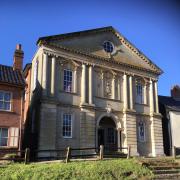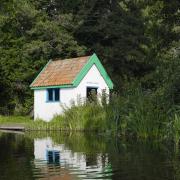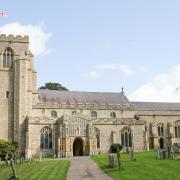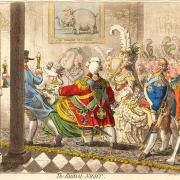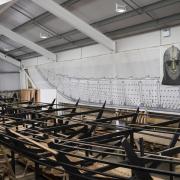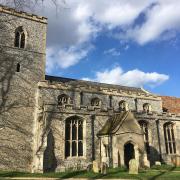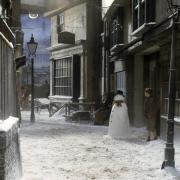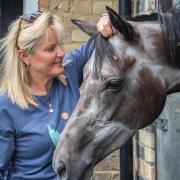Elizabeth Simpson was born in Stanningfield, near Bury St Edmunds, on October 15 1753. It’s a small place with Grade I listed St Nicholas church dating back to Norman times, and a suitable pile for the local worthy, Coldham Hall, also Grade I listed and built in 1574.
Elizabeth was the eighth of nine children born to farmer John Simpson and Mary née Rushbrook. The family was Catholic, one of several in the neighbourhood, which helps to explain a local connection with the Gunpowder Plot of 1605.
Elizabeth was home educated with her sisters while her brother went off to school. John Simpson died in 1761, so it was Mary who influenced her seven-year-old daughter's future career by taking her to the theatre in nearby Bury St Edmunds.

Sure enough Elizabeth set her sights on acting from a young age, despite a speech impediment, which she worked diligently to overcome. Her family were less certain and didn’t exactly encourage her attempt to gain some sort of position at the Norwich Theatre in early 1770 at the age of 16. In the same year, however, her brother George became an actor which probably fuelled her aspirations.
In typically headstrong fashion, come late 1772 Elizabeth took off for London. She was certainly brave, but at 18 and unchaperoned in London, she had to resist unwanted advances while trying to launch a career. It seems young Elizabeth could look after herself though; one unwanted suitor had a basin of water chucked in his face, and it wasn’t cold either.
But only two months after arriving in the capital, she accepted a marriage proposal from Joseph Inchbald, 18 years her senior, also a Catholic and an actor. Maybe he was the new father figure she needed.

Elizabeth married Inchbald in London in 1772, the same year she made her stage debut playing Shakespeare's Cordelia in Bristol; perhaps being married to a fellow actor gave her the required inspiration and kudos. Joseph already had a couple of illegitimate children but wouldn’t have any more with Elizabeth. It’s believed the marriage wasn’t a bed of roses.
But the couple did act together, appearing first on September 4, 1772 in King Lear. The following month they began touring Scotland with a theatre company, which was to last four years before they embarked for France in 1776. It was a madcap venture and they were soon back in Britain, which at least enabled them to become acquainted with the famous actress Sarah Siddons. She and her brother, another esteemed actor, John Philip Kemble, both became valuable friends. If you’re trying to forge a theatre career you could do worse than befriend a couple of practised performers.
Joseph died suddenly in June 1779, but Elizabeth continued acting and appeared at Covent Garden, whose company she joined in 1780, the year of her London debut. In fact, her acting career was unspectacular. It was after Joseph’s death that she achieved fame as a playwright and novelist.

She began with small pieces, appearing for example in The Artist and the Edinburgh Review, but eventually wrote at least 19 plays – maybe as many as 23 – which were performed in London between 1784 and 1805. They included The Wedding Day; A Mogul Tale, the first to be staged in which Elizabeth was cast in the lead; and Lovers’ Vows, which was sufficiently renowned to be mentioned in Jane Austen's Mansfield Park for its moral focus.
She was among the first women to truly make a name as a playwright, her plays seen by both George III and the Prince Regent. She also became Britain’s first prominent female theatre critic and, by 1789, Elizabeth was earning enough from writing to abandon acting.
She also penned the novels A Simple Story (1791) and Nature and Art (1796), which have attracted much attention and should probably be regarded as her finest works. One critic referred to her early ‘novel of passion’, A Simple Story, as ‘the most elegant fiction of the eighteenth century’. High praise for this early practitioner of romantic fiction. There’s a sincerity to her novels, as she sets out her radical beliefs, more so than in her plays where she was mindful of what was acceptable to theatre managers at the time.

Among her friends was the radical philosopher William Godwin (1756-1836), father of Mary Shelley, creator of Frankenstein. William and Elizabeth shared similar views, but while she may have been something of a political radical, Elizabeth also sought to be socially respectable. She famously quarrelled with Godwin’s wife, Mary Wollstonecraft, over the fact that Mary's marriage to Godwin confirmed she had not been married to Gilbert Imlay, the father of her elder daughter Fanny, making the child illegitimate.
Elizabeth was so successful she didn’t need to contemplate remarrying. She’d achieved financial independence, an extraordinary feat for any woman of that time. She was lucky in looks, witty, charming and generous, but she also had a strong personality, was independent and impatient to succeed in life. She was socially respectable too, her life regarded as ‘stainless’.
She died on August 1821 in Kensington, aged 67. She was buried there, her grave declaring that she was someone ‘whose writings will be cherished while truth, simplicity and feelings command public admiration’.








